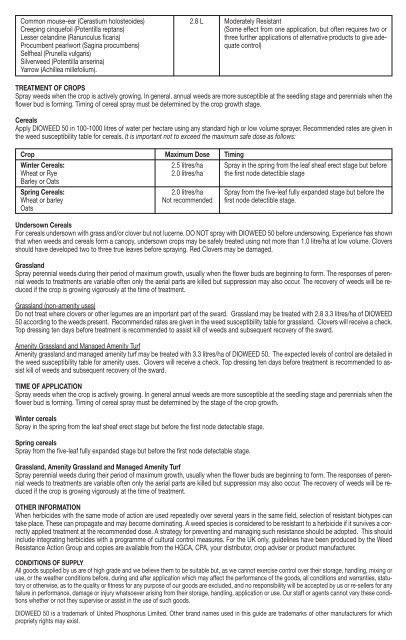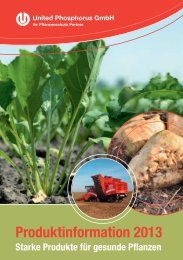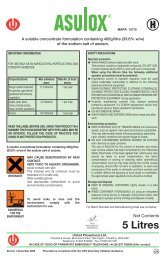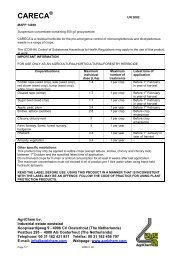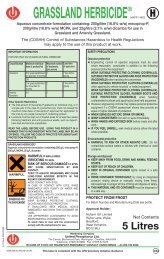DioWeed 50® - United Phosphorus Limited
DioWeed 50® - United Phosphorus Limited
DioWeed 50® - United Phosphorus Limited
You also want an ePaper? Increase the reach of your titles
YUMPU automatically turns print PDFs into web optimized ePapers that Google loves.
Common mouse-ear (Cerastium holosteoides)<br />
Creeping cinquefoil (Potentilla reptans)<br />
Lesser celandine (Ranunculus ficaria)<br />
Procumbent pearlwort (Sagina procumbens)<br />
Selfheal (Prunella vulgaris)<br />
Silverweed (Potentilla anserina)<br />
Yarrow (Achillea millefolium).<br />
TREATMENT OF CROPS<br />
Spray weeds when the crop is actively growing. In general, annual weeds are more susceptible at the seedling stage and perennials when the<br />
flower bud is forming. Timing of cereal spray must be determined by the crop growth stage.<br />
Cereals<br />
Apply DIOWEED 50 in 100-1000 litres of water per hectare using any standard high or low volume sprayer. Recommended rates are given in<br />
the weed susceptibility table for cereals. It is important not to exceed the maximum safe dose as follows:<br />
Crop<br />
Winter Cereals:<br />
Wheat or Rye<br />
Barley or Oats<br />
Spring Cereals:<br />
Wheat or barley<br />
Oats<br />
Maximum Dose<br />
2.5 litres/ha<br />
2.0 litres/ha<br />
2.0 litres/ha<br />
Not recommended<br />
Undersown Cereals<br />
For cereals undersown with grass and/or clover but not lucerne. DO NOT spray with DIOWEED 50 before undersowing. Experience has shown<br />
that when weeds and cereals form a canopy, undersown crops may be safely treated using not more than 1.0 litre/ha at low volume. Clovers<br />
should have developed two to three true leaves before spraying. Red Clovers may be damaged.<br />
Grassland<br />
Spray perennial weeds during their period of maximum growth, usually when the flower buds are beginning to form. The responses of perennial<br />
weeds to treatments are variable often only the aerial parts are killed but suppression may also occur. The recovery of weeds will be reduced<br />
if the crop is growing vigorously at the time of treatment.<br />
Grassland (non-amenity uses)<br />
Do not treat where clovers or other legumes are an important part of the sward. Grassland may be treated with 2.8 3.3 litres/ha of DIOWEED<br />
50 according to the weeds present. Recommended rates are given in the weed susceptibility table for grassland. Clovers will receive a check.<br />
Top dressing ten days before treatment is recommended to assist kill of weeds and subsequent recovery of the sward.<br />
Amenity Grassland and Managed Amenity Turf<br />
Amenity grassland and managed amenity turf may be treated with 3.3 litres/ha of DIOWEED 50. The expected levels of control are detailed in<br />
the weed susceptibility table for amenity uses. Clovers will receive a check. Top dressing ten days before treatment is recommended to assist<br />
kill of weeds and subsequent recovery of the sward.<br />
TIME OF APPLICATION<br />
Spray weeds when the crop is actively growing. In general annual weeds are more susceptible at the seedling stage and perennials when the<br />
flower bud is forming. Timing of cereal spray must be determined by the stage of the crop growth.<br />
Winter cereals<br />
Spray in the spring from the leaf sheaf erect stage but before the first node detectable stage.<br />
Spring cereals<br />
Spray from the five-leaf fully expanded stage but before the first node detectable stage.<br />
2.8 L Moderately Resistant<br />
(Some effect from one application, but often requires two or<br />
three further applications of alternative products to give adequate<br />
control)<br />
Timing<br />
Spray in the spring from the leaf sheaf erect stage but before<br />
the first node detectible stage<br />
Spray from the five-leaf fully expanded stage but before the<br />
first node detectible stage.<br />
Grassland, Amenity Grassland and Managed Amenity Turf<br />
Spray perennial weeds during their period of maximum growth, usually when the flower buds are beginning to form. The responses of perennial<br />
weeds to treatments are variable often only the aerial parts are killed but suppression may also occur. The recovery of weeds will be reduced<br />
if the crop is growing vigorously at the time of treatment.<br />
OTHER INFORMATION<br />
When herbicides with the same mode of action are used repeatedly over several years in the same field, selection of resistant biotypes can<br />
take place. These can propagate and may become dominating. A weed species is considered to be resistant to a herbicide if it survives a correctly<br />
applied treatment at the recommended dose. A strategy for preventing and managing such resistance should be adopted. This should<br />
include integrating herbicides with a programme of cultural control measures. For the UK only, guidelines have been produced by the Weed<br />
Resistance Action Group and copies are available from the HGCA, CPA, your distributor, crop adviser or product manufacturer.<br />
CONDITIONS OF SUPPLY<br />
All goods supplied by us are of high grade and we believe them to be suitable but, as we cannot exercise control over their storage, handling, mixing or<br />
use, or the weather conditions before, during and after application which may affect the performance of the goods, all conditions and warranties, statutory<br />
or otherwise, as to the quality or fitness for any purpose of our goods are excluded, and no responsibility will be accepted by us or re-sellers for any<br />
failure in performance, damage or injury whatsoever arising from their storage, handling, application or use. Our staff or agents cannot vary these conditions<br />
whether or not they supervise or assist in the use of such goods.<br />
DIOWEED 50 is a trademark of <strong>United</strong> <strong>Phosphorus</strong> <strong>Limited</strong>. Other brand names used in this guide are trademarks of other manufacturers for which<br />
propriety rights may exist.


